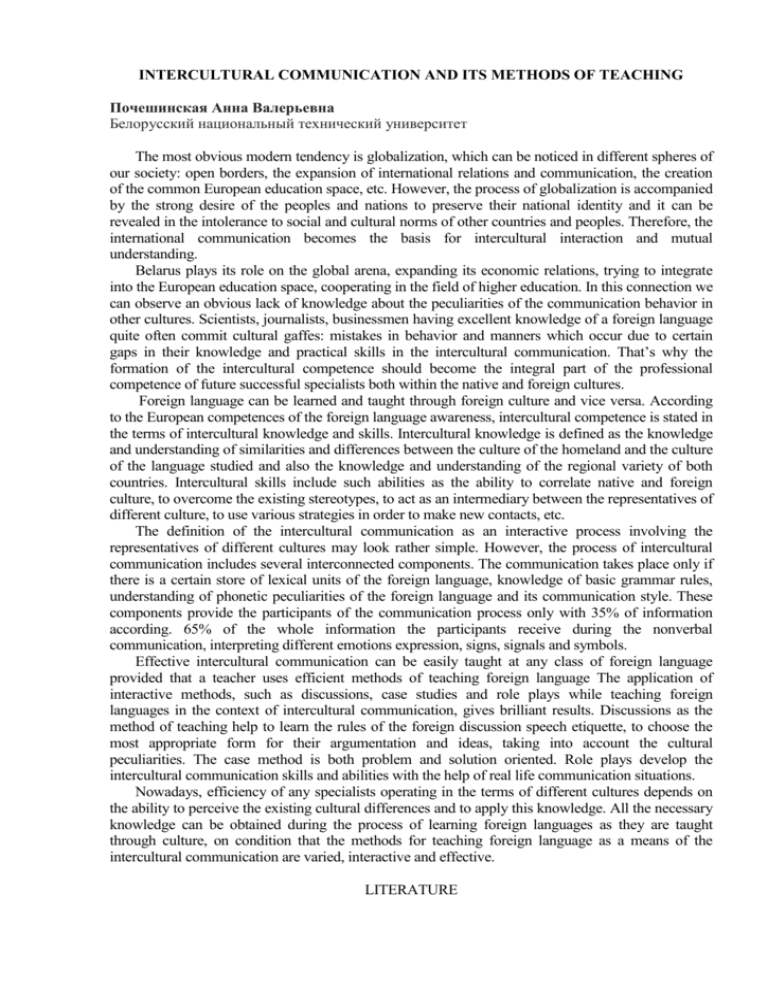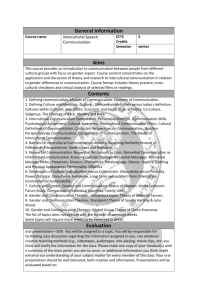INTERCULTURAL COMMUNICATION AND ITS METHODS OF
advertisement

INTERCULTURAL COMMUNICATION AND ITS METHODS OF TEACHING Почешинская Анна Валерьевна Белорусский национальный технический университет The most obvious modern tendency is globalization, which can be noticed in different spheres of our society: open borders, the expansion of international relations and communication, the creation of the common European education space, etc. However, the process of globalization is accompanied by the strong desire of the peoples and nations to preserve their national identity and it can be revealed in the intolerance to social and cultural norms of other countries and peoples. Therefore, the international communication becomes the basis for intercultural interaction and mutual understanding. Belarus plays its role on the global arena, expanding its economic relations, trying to integrate into the European education space, cooperating in the field of higher education. In this connection we can observe an obvious lack of knowledge about the peculiarities of the communication behavior in other cultures. Scientists, journalists, businessmen having excellent knowledge of a foreign language quite often commit cultural gaffes: mistakes in behavior and manners which occur due to certain gaps in their knowledge and practical skills in the intercultural communication. That’s why the formation of the intercultural competence should become the integral part of the professional competence of future successful specialists both within the native and foreign cultures. Foreign language can be learned and taught through foreign culture and vice versa. According to the European competences of the foreign language awareness, intercultural competence is stated in the terms of intercultural knowledge and skills. Intercultural knowledge is defined as the knowledge and understanding of similarities and differences between the culture of the homeland and the culture of the language studied and also the knowledge and understanding of the regional variety of both countries. Intercultural skills include such abilities as the ability to correlate native and foreign culture, to overcome the existing stereotypes, to act as an intermediary between the representatives of different culture, to use various strategies in order to make new contacts, etc. The definition of the intercultural communication as an interactive process involving the representatives of different cultures may look rather simple. However, the process of intercultural communication includes several interconnected components. The communication takes place only if there is a certain store of lexical units of the foreign language, knowledge of basic grammar rules, understanding of phonetic peculiarities of the foreign language and its communication style. These components provide the participants of the communication process only with 35% of information according. 65% of the whole information the participants receive during the nonverbal communication, interpreting different emotions expression, signs, signals and symbols. Effective intercultural communication can be easily taught at any class of foreign language provided that a teacher uses efficient methods of teaching foreign language The application of interactive methods, such as discussions, case studies and role plays while teaching foreign languages in the context of intercultural communication, gives brilliant results. Discussions as the method of teaching help to learn the rules of the foreign discussion speech etiquette, to choose the most appropriate form for their argumentation and ideas, taking into account the cultural peculiarities. The case method is both problem and solution oriented. Role plays develop the intercultural communication skills and abilities with the help of real life communication situations. Nowadays, efficiency of any specialists operating in the terms of different cultures depends on the ability to perceive the existing cultural differences and to apply this knowledge. All the necessary knowledge can be obtained during the process of learning foreign languages as they are taught through culture, on condition that the methods for teaching foreign language as a means of the intercultural communication are varied, interactive and effective. LITERATURE 1. Baidarov, E. The influence of globalization on human culture and values // Internet-journal Credo New. – Internet-resource. Access regime: http://credonew.ru/content/view/510/30/#_ednref9 2. Lewis, R. When Cultures Collide. Managing Successfully Across Cultures. L., 1999. 3. Грушевицкая, Т. Основы межкультурной коммуникации : учебник для вузов / Т. Г. Грушевицкая, В. Д. Попков, А. П. Садохин. – Москва : ЮНИТИ-ДАНА, 2003. – 352 с. 4. Панина, Т. С. Современные способы активизации обучения : учебное пособие для студ. высш. учеб. заведений / Т. С. Панина, Вавилова Л. Н. ; под ред. Т. С. Паниной. – Москва : Академия, 2006. Тер-Минасова, С. Г. Язык и межкультурная коммуникация [Электронный ресурс]. – Режим доступа: http://www.gumer.info/bibliotek_Buks/Linguist/Ter/_Index. php.






